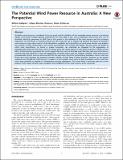| dc.contributor.author | Hallgren, Willow | |
| dc.contributor.author | Gunturu, Udaya Bhaskar | |
| dc.contributor.author | Schlosser, Adam | |
| dc.date.accessioned | 2014-09-09T16:30:55Z | |
| dc.date.available | 2014-09-09T16:30:55Z | |
| dc.date.issued | 2014-07 | |
| dc.identifier.issn | 1932-6203 | |
| dc.identifier.uri | http://hdl.handle.net/1721.1/89236 | |
| dc.description.abstract | Australia’s wind resource is considered to be very good, and the utilization of this renewable energy resource is increasing rapidly: wind power installed capacity increased by 35% from 2006 to 2011 and is predicted to account for over 12% of Australia’s electricity generation in 2030. Due to this growth in the utilization of the wind resource and the increasing importance of wind power in Australia’s energy mix, this study sets out to analyze and interpret the nature of Australia’s wind resources using robust metrics of the abundance, variability and intermittency of wind power density, and analyzes the variation of these characteristics with current and potential wind turbine hub heights. We also assess the extent to which wind intermittency, on hourly or greater timescales, can potentially be mitigated by the aggregation of geographically dispersed wind farms, and in so doing, lessen the severe impact on wind power economic viability of long lulls in wind and power generated. Our results suggest that over much of Australia, areas that have high wind intermittency coincide with large expanses in which the aggregation of turbine output does not mitigate variability. These areas are also geographically remote, some are disconnected from the east coast’s electricity grid and large population centers, which are factors that could decrease the potential economic viability of wind farms in these locations. However, on the eastern seaboard, even though the wind resource is weaker, it is less variable, much closer to large population centers, and there exists more potential to mitigate it’s intermittency through aggregation. This study forms a necessary precursor to the analysis of the impact of large-scale circulations and oscillations on the wind resource at the mesoscale. | en_US |
| dc.description.sponsorship | Massachusetts Institute of Technology. Joint Program on the Science & Policy of Global Change | en_US |
| dc.language.iso | en_US | |
| dc.publisher | Public Library of Science | en_US |
| dc.relation.isversionof | http://dx.doi.org/10.1371/journal.pone.0099608 | en_US |
| dc.rights | Creative Commons Attribution | en_US |
| dc.rights.uri | http://creativecommons.org/licenses/by/4.0/ | en_US |
| dc.source | Public Library of Science | en_US |
| dc.title | The Potential Wind Power Resource in Australia: A New Perspective | en_US |
| dc.type | Article | en_US |
| dc.identifier.citation | Hallgren, Willow, Udaya Bhaskar Gunturu, and Adam Schlosser. “The Potential Wind Power Resource in Australia: A New Perspective.” Edited by Francois G. Schmitt. PLoS ONE 9, no. 7 (July 2, 2014): e99608. | en_US |
| dc.contributor.department | Massachusetts Institute of Technology. Joint Program on the Science & Policy of Global Change | en_US |
| dc.contributor.mitauthor | Hallgren, Willow | en_US |
| dc.contributor.mitauthor | Gunturu, Udaya Bhaskar | en_US |
| dc.contributor.mitauthor | Schlosser, Adam | en_US |
| dc.relation.journal | PLoS ONE | en_US |
| dc.eprint.version | Final published version | en_US |
| dc.type.uri | http://purl.org/eprint/type/JournalArticle | en_US |
| eprint.status | http://purl.org/eprint/status/PeerReviewed | en_US |
| dspace.orderedauthors | Hallgren, Willow; Gunturu, Udaya Bhaskar; Schlosser, Adam | en_US |
| mit.license | PUBLISHER_CC | en_US |
| mit.metadata.status | Complete | |
